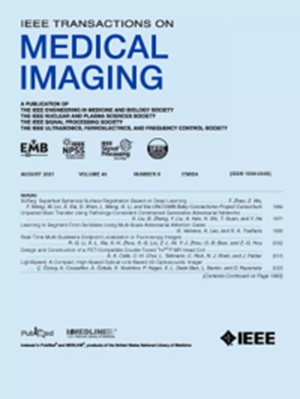基于条件虚拟成像的少镜头血管图像分割。
IF 9.8
1区 医学
Q1 COMPUTER SCIENCE, INTERDISCIPLINARY APPLICATIONS
引用次数: 0
摘要
在医学图像处理领域,血管图像分割在临床诊断、治疗计划、预后和医疗决策中起着至关重要的作用。血管图像的准确和自动分割可以帮助临床医生了解血管网络结构,从而做出更明智的医疗决策。然而,由于血管分支精细且对比度低,手工标注血管图像耗时且具有挑战性,特别是在医学成像领域,标注需要专业知识和临床专业知识。当只有少量带注释的血管图像可用时,数据驱动的深度学习模型难以达到良好的性能。为了解决这一问题,本文提出了一种新的条件虚拟成像(CVI)框架,用于小帧血管图像分割学习。该框架将有限的标注数据与大量的未标注数据相结合,生成高质量的图像,有效提高了分割学习的准确性和鲁棒性。我们的方法主要包括两个创新:第一,对齐图像掩码对生成,它利用大型预训练模型的强大图像生成能力,仅使用少量训练图像就能生成具有复杂结构的高质量血管图像;二是双一致性学习(Dual-Consistency Learning, DCL)策略,该策略同时训练生成器和分割模型,使它们相互学习,最大限度地利用有限的数据。实验结果表明,我们的CVI框架可以生成高质量的医学图像,并有效提高了少镜头场景下分割模型的性能。我们的代码将在网上公开。本文章由计算机程序翻译,如有差异,请以英文原文为准。
Conditional Virtual Imaging for Few-Shot Vascular Image Segmentation.
In the field of medical image processing, vascular image segmentation plays a crucial role in clinical diagnosis, treatment planning, prognosis, and medical decision-making. Accurate and automated segmentation of vascular images can assist clinicians in understanding the vascular network structure, leading to more informed medical decisions. However, manual annotation of vascular images is time-consuming and challenging due to the fine and low-contrast vascular branches, especially in the medical imaging domain where annotation requires specialized knowledge and clinical expertise. Data-driven deep learning models struggle to achieve good performance when only a small number of annotated vascular images are available. To address this issue, this paper proposes a novel Conditional Virtual Imaging (CVI) framework for few-shot vascular image segmentation learning. The framework combines limited annotated data with extensive unlabeled data to generate high-quality images, effectively improving the accuracy and robustness of segmentation learning. Our approach primarily includes two innovations: First, aligned image-mask pair generation, which leverages the powerful image generation capabilities of large pre-trained models to produce high-quality vascular images with complex structures using only a few training images; Second, the Dual-Consistency Learning (DCL) strategy, which simultaneously trains the generator and segmentation model, allowing them to learn from each other and maximize the utilization of limited data. Experimental results demonstrate that our CVI framework can generate high-quality medical images and effectively enhance the performance of segmentation models in few-shot scenarios. Our code will be made publicly available online.
求助全文
通过发布文献求助,成功后即可免费获取论文全文。
去求助
来源期刊

IEEE Transactions on Medical Imaging
医学-成像科学与照相技术
CiteScore
21.80
自引率
5.70%
发文量
637
审稿时长
5.6 months
期刊介绍:
The IEEE Transactions on Medical Imaging (T-MI) is a journal that welcomes the submission of manuscripts focusing on various aspects of medical imaging. The journal encourages the exploration of body structure, morphology, and function through different imaging techniques, including ultrasound, X-rays, magnetic resonance, radionuclides, microwaves, and optical methods. It also promotes contributions related to cell and molecular imaging, as well as all forms of microscopy.
T-MI publishes original research papers that cover a wide range of topics, including but not limited to novel acquisition techniques, medical image processing and analysis, visualization and performance, pattern recognition, machine learning, and other related methods. The journal particularly encourages highly technical studies that offer new perspectives. By emphasizing the unification of medicine, biology, and imaging, T-MI seeks to bridge the gap between instrumentation, hardware, software, mathematics, physics, biology, and medicine by introducing new analysis methods.
While the journal welcomes strong application papers that describe novel methods, it directs papers that focus solely on important applications using medically adopted or well-established methods without significant innovation in methodology to other journals. T-MI is indexed in Pubmed® and Medline®, which are products of the United States National Library of Medicine.
 求助内容:
求助内容: 应助结果提醒方式:
应助结果提醒方式:


